Back to contents of Teachings of Islam (Talim-ul-Haq)
Contents of Part 10
- The Muhtadhar
- The Talqeen
- What to do after a person has passed away
- Requirements for male and female kafn (burial shroud)
- Requirements for Qabr (grave)
- Types of Qabr
- The Kafn
- Kafn for male and female
- Ghusl requirements
- Who should perform the Ghusl
- The Ghusl (masnoon sequence)
- How the Kafn should be put on the male and the female
- Prohibited articles in the Kafn
- What to do after the Kafn
- How the Janaazah should be carried
- Where should the Janaazah Namaaz be performed
- Times when Janaazah Namaaz may be performed
- The Janaazah Namaaz
- Masnoon manner of performing the Janaazah Namaaz
- Late comers to the Janaazah Namaaz
- The Shar'ee method of Dafn (burial)
- How the Qabr should be filled and shaped
- Masnoon duas that may be read in the Janaazah Namaaz
- Ta'ziat (to sympathise with the bereaved)
- Visiting the Qabrastaan (graveyard)
- What to read when entering the Qabrastaan
- What to recite when in the Qabrastaan
- Period of Iddat
- A few noteworthy Masaail
A person on whom the signs of DEATH are clearly seen is called a MUHTADAR. It is SUNNAT to let him lie on his RIGHT side facing the QIBLA. It is permitted that he be positioned to lie on his BACK with his FEET towards the QIBLA, and the head slightly raised with a cushion so that it faces the Qibla. All the bed linen must be PAAK. If moving the Muhtadar causes him any discomfort then leave him in any convenient position.
It is desirable to use LOBAAN, Itr or any other aromatics that are Paak in the room. Anyone who is in the state of Janaabat, Haiz or Nifaas must leave the apartment.
At this time the recitals of Surahs YASEEN (starting at the l7th Ruku of the 22nd Para) and RA'D (beginning at the 6th Ruku of the l3th Para) is recommended. This may be done in the same room. When one is incapable of reciting the Quraan, someone else may be requested to recite these Surahs or any other portion of the Quraan.
TALQEEN is to remind the dying person of the two SHAHADATS, (i.e. Ash
hadu alla ilaha illall-lahu wa ash hadu anna Muhammadan abduhu wa Rasuluh).
When the end nears the dying person's breath quickens, the knees become
so weak that they cannot move, the nose becomes bent and the temples subside.
By these signs understand that the person is nearing the end.
The Talqeen should be read before the dying person takes his last breaths.
The Muhtadar must NOT be asked or ORDERED to read the Kalimah, but must
be helped to recall it. This can easily be done by reciting the Kalimah
aloud while being present in the room. Once the departing person utters,
the Kalimah all who are present should remain SILENT. The dying person
should NOT be drawn into any WORLDLY discussions, but if he discusses any
worldly affair, then the Talqeen should be repeated. After the Muhtadar
passes away, his mouth should be kept CLOSED by fastening a piece of Paak
material around his chin and over his head, his eyes should also be closed.
Both feet should be tied together with a similar piece of cloth, and the
body covered with a Paak sheet
The one who does this should read: -

He may further read: -

N.B. It is MAKROOH (disliked) to recite the Holy Quraan near the deceased person’s body during the period between DEATH and the GHUSL.
All the individuals of the deceased’s family may read: -

And those who are grieved by this demise may read:-


1. Obtain a doctor's certificate.
2. Obtain a burial order.
3. Obtain a death certificate.
4. If the body is to be removed from one Municipality to another, (e.g.
from Umzinto to Durban) then it is necessary to obtain a REMOVAL ORDER
from the police of the town in which the death took place.
5. If the death is due to unnatural causes (e.g. drowning or a motor
accident, etc.) then one must comply with the legal requirements.
6. Inform relatives and friends of the death and of the time of Janazah.
7. Prepare the QAB'R.
8. Perform GHUSL.
9. Put on the KAFAN.
10. Arrange transport if the QABRASTAAN cemetery is at a distance.
a) SHEETING: 4 metres-140 cm, 150 cm or 180 cm wide Izaar according
to the size of the body (1,75 metres for Izaar and 2,Z5 metres for Lifafah)
OR CALICO: 8 metres-90 cm wide (3,50 metres for Izaar and 4,50 Lifafah
metres for Lifafah). These have to be cut in half and sewn together.
b) CALICO: 1,80 metres, 90 cm wide for Qamees.
c) Any other material 2,50 metres, 115 cm wide this has to be made
into two pieces for Tehbands, about 115 cm x 115 cm. The balance should
be used for making up bag like mittens to be used for covering hands when
performing Ghusl. A few strips must be kept for fastening the bags onto
the hands and for tying the Kafn after it has been put on.
d) 6O grams camphor cut fine, 60 grams sandal wood powder and rose
water for paste to be put on parts of the body that touch the ground when
making Sajdah.
e) One small bottle Itr or Hunoot if easily available, for males only.
(Hunoot is anything with which a corpse is perfumed, consisting of musk,
sandal wood, ambergis and camphor or any PAAK substance).
ADDITIONAL KAFN REQUIREMENTS FOR FEMALES
a) CALICO: 1,40 metres, 90 cm wide for, Khimaar (Orni).
b) CALICO: 1,80 to 2,50 metres, 90 cm wide for a woman's breast, (Sina
band).
| Name of Garment | Length | Width | Description |
| Izaar | 180 cm
(2 yds) |
150/180 cm
(60"/72") |
To cover from head to toe |
| Lifafah
Chadar |
225 cm
(2 1/2 yds) |
150/180 cm
(60"/72") |
15 cm longer
than Izaar |
| Qamees
Kafni |
180 to 250 yds
(2 to 2 3/4 yds) |
90 cm
(36") |
From shoulder to below the knees |
| Khimaar
Orni |
140 cm
(1 1/2 yds) |
90 cm
(36") |
To cover head and hair over breasts |
| Sina'band | 180 to 250 yds
(2 to 2 3/4 yds) |
90 cm
(36") |
From under the armpits to the thighs |
a) Unbaked bricks, bamboo or timber where the ground is soft.
b) Sufficient spades.
c) The approximate depth of a grave for adults should be according
to the height of the deceased.
Graves are of two types:
The Lahad: Where the ground and sides of the Qabr are firm then a recess should be dug on the Qiblah side to allow placing the body in the recess. Unbaked bricks should preferably be used to close the recess and made to fit neatly.
The Shiq: where the soft nature of the ground does not allow a LAHAD to be made then a shallow trench should be dug in the centre at the bottom of the Kabr to allow the body to be placed in this trench. Timber may be used to cover this. The use of any fabrics or blankets etc is undesirable and wasteful. The bamboo or planks must be cut to size and set to fit properly in the grave before burial to avoid last minute inconvenience.
Note: It is MAKROOH (undesirable) to dig out and prepare one’s own grave during one lifetime.
The Kafn are the grave clothes of the dead. It is desirable that the
Kafn be of white material and of medium quality according to the status
of the deceased. Rasulullah ![]() said, "Do not use expensive cloth in Kafn because it will very soon
decay." It is PERMISSIBLE to prepare one's Kafn during one's lifetime.
This will avoid last minute rush and inconvenience.
said, "Do not use expensive cloth in Kafn because it will very soon
decay." It is PERMISSIBLE to prepare one's Kafn during one's lifetime.
This will avoid last minute rush and inconvenience.
The MASNOON Kafn for a male is an IZAAR, QAMEES and LIFAFAH. The Izaar in this case is a sheet from the head to the feet, whereas the Qamees is a long sheet that has to be folded in half and an opening cut to allow it to be put on as a shirt. The latter will have no pockets, sleeves or seams. The Lifafah is a sheet from above the head to below the feet (see diagrams on page 45) Just TWO the Izaar and Lifafah will also suffice, but it is SUNNAT to have the THREE. It is MAKROOH to use LESS than two without a valid reason.
The MASNOON Kafn for a female consists of an IZAAR, KHIMAAR (Orni), QAMEES, LIFAFA and a piece of material to hold the breasts (SINA'BAND). The Khimaar is the Veil. The piece of material to hold the breasts should preferably be from the breasts to the thighs. Three garments i.e. Izaar, Lifafah and Khimaar will suffice, but it is SUNNAT to have FIVE. It is MAKROOH to use less than THREE, except when it is NOT available. It is the duty of the husband to bear the burial expenses of the wife. The Kafn could be smoked with LOBAAN etc. but NOT scented with Itr. Children's Kafn should be cut to appropriate size.
1. Clean lukewarm water.
2. A broad bench, stand or platform.
3. Two large buckets for warm water, one small bucket or utensil, this
is for the water to be mixed with a little camphor for use at the end of
the Ghusl.
4. Two jugs or mugs for pouring water over the corpse.
5. Leaves of BER tree (Zizyphus Jujuba) if easily available, to be
mixed with the lukewarm water and a cake of soap.
6. 250 g. of cotton wool.
7. Two Tehbands and two bag like mittens with strips.
8. A scissor for removing the deceased's clothing.
9. Lobaan (Frankincense-Aromatic gum resin obtained from trees) or
any other Paak incense for smoking the bench, stand or platform.
10. One clean sheet to cover during Ghusl and one to cover before and
after Ghusl.
11. One clean towel or a piece of material for drying the corpse.
The Ghusl is the bath for the body of the dead person. An adult male should be bathed by his FATHER, SON or BROTHER. An adult female by her MOTHER, DAUGHTER or SISTER. If none of these persons are present then any : near relative could carry out this duty, (male for male, and female for female). If any of these are not in the position to perform the Ghusl, then the most pious person present should be requested to carry out this rite. The person giving the Ghusl should be assisted by others. The person performing the Ghusl must himself or herself be Paak and in a state of Wudhu. It is MAKROOH for a woman who is MENSTRUATING or in a state of NIFAAS (period after birth of a child) to perform the Ghusl.
If a MALE passes away and there are NO MALES to bathe him, then no other woman besides him WIFE is permitted to carry out the Ghusl.
In the case of a WOMAN, if there are no LADIES to perform the GHUSL, the HUSBAND CANNOT perform the Ghusl of his WIFE.
In both instances TAYAMMUM should be performed. The Tayammum for Ghusl is the same as that for Wudhu.
A CHILD who has NOT reached the age of PUBERTY (Male or Female) may be given Ghusl by any adult, male or female, if a member of the same sex is not available.
A bench, stand or platform on which the Ghusl will be carried out must
be washed, cleaned and fumigated with Lobaan or any other Paak aromatic,
three, five or seven times
During GHUSL it is PERMISSIBLE to place the one of the following two
positions:
WHICHEVER POSITION IS CONVENIENT IS PERMISSIBLE.
a. Having the LEGS facing the QIBLAH.
b. Having the FACE towards the QIBLAH (as a person is made to lie in
the grave.
However, it is preferable to place the body with the FACE towards the QIBLAH as NABI has mentioned that the Ka'ba is the Qiblah of both the living and the dead.
NO HAIR of the head, beard or any other part of the body must be cut, shaved, trimmed or combed. The nails too should NOT be cut. Circumcision is also NOT permissible. All rings, jewelery wigs etc. should be removed. Where the false teeth of the dead person can easily be removed, these should preferably be taken out.
Thereafter the body should be put on the stand, the SATR (private parts) covered (The male's Satr from the navel to the knees and the female's from above the breast to the ankles).
The stomach should gently be massaged then both the Istinja places should be washed with mittens on without looking at the private parts.
The nostrils, ears and mouth should be closed with cotton wool to prevent water from entering the body during the Ghusl.
If the deceased has reached the age of puberty and was one on whom Namaaz was Farz, he must be given WUDHU. This Wudhu is similar to that of Namaaz with the exception of GARGLING and putting water into the NOSTRILS. The proper sequence should be to wash: -
1. The FACE.
2. ARMS to the ELBOWS.
3. MASAH of the HEAD and
4. FEET up to the ANKLES.
If the dead person is in the state of JANAABAT, HAIZ or NIFAAS (a state in which GHUSL is WAAJIB on him/her), then the mouth HAS TO be gargled and nostrils be made wet. This can be done with a little bit of cotton wool.
After Wudhu, the head and beard should first be washed with soap or any other cleansing agent. If these are not readily available, pure clean water will suffice. The temperature of the water must be that which a living person normally uses when bathing.
Thereafter the body should be tilted onto it's left side to allow the right side to be washed first. Warm water should now be poured over the body from head to the toes once and the body should be washed with soap until the water has reached the bottom (left side). The body should now be washed again twice by pouring water from head to toe . The body should then be turned onto it's right side and the left side bathed similarly.
Thereafter the body should be lifted slightly to a sitting position and the stomach be gently massaged with a downward stroke. Whatever comes out of the body should be washed away. The WUDHU and GHUSL need NOT be REPEATED in case any impurity does come out.
The body should once again be turned onto it's left side and camphor water poured over it from head to toe three times.
All the cotton wool should now be removed from the mouth, ears and nose.
With this the Ghusl is complete and the body could be wiped with a towel or a piece of material. The SATR must be kept covered. The FIRST Tehband will be wet due to the Ghusl. It should thus be changed for a second one. Care should be taken that while doing this the SATR is NOT exposed.
The body should then be wrapped in saheet and carried carefully onto the Kafn.
Masnoon sequence
1. First spread the LIFAFAH on the floor then on it the IZAAR and on
it that portion of the QAMEES that will be under the body. The portion
that will cover the top of the body should be folded and put at the head
side.
2. Lower the body gently onto the Kafn and cover the top of the body
upto the calves with the folded portion of the Qamees.
3. Remove the TEHBAND and sheet used for covering the SATR.
4. Rub ITR or HUNOOT on the HEAD and BEARD.
5. Then rub camphor mixture paste on the the places of SAJDAH (i.e.
those parts of the body that touch the ground in NAMAAZ: forehead, nose,
both the palms, knees and the fore feet).
6. First fold the LEFT flap and on it the RIGHT flap of the IZAAR over
the QAMEES.
7. Thereafter fold the LIFAFAH in the same manner. Remember that the
RIGHT flap must always be on the TOP.
8. Lastly fasten the ends of the LIFAFAH at the head side, feet and
around the middle with strips of the cloth.
For the Female
1. First spread the LIFAFAH out on the ground then the SINABAND on it
the IZAAR and then the QAMEES in the same manner stated for males. The
SINABAND may also be placed between the Izaar and Qamees or lastly over
the Lifafah.
2. Lower the body gently onto the Kafn and cover the top of the body
upto the calves with the folded portion of the Qamees.
3. Remove the Tehband and sheet used for covering the Satr. Do NOT
use Itr, Surmah or any other make up.
4. Rub camphor mixture onto the places of Sajdah, i.e. the forehead,
nose. both palms, knees and the fore feet.
5. The hair should be divided into two parts and put onto the right
and left breast over the Qamees.
6. Cover the head and hair with the Orni. Do not fasten or fold it.
7. Fold the Izaar, the left flap first and then the right over the
Qamees and Orni.
8. Now close the Sinaband (breast cover) over these in the same manner.
9. Close the Lifafah, the left flap first and then the right.
10. Lastly fasten the ends of the Lifafah at the head side, feet and
around the middle with strips of cloth, to keep the complete Kafn in place.
1. It is prohibited to enclose any charter or any Dua in the Kafn.
2. It is forbidden to write the Kalimah or any other Duaa on the Kafn
or on the chest of the deceased with camphor, ink, etc.
With the completion of the Ghusl and Kafn, the Mayyit (deceased person)
is ready for DAFAN (burial). No time should be wasted and the Namaaz of
the Janaazah should be arranged without delay. Rasulullah ![]() has said: "If a person passes away, hasten him to his grave and do
not keep him away." The Janaazah Namaaz should be arranged quickly
and the Mayyit should be buried in the nearest Muslim Qabrastaan (cemetery).
To transport the body over long distances is undesirable. It is also MAKROOH
to delay the Janaazah Namaaz and wait for late comers to increase the Jama'at.
has said: "If a person passes away, hasten him to his grave and do
not keep him away." The Janaazah Namaaz should be arranged quickly
and the Mayyit should be buried in the nearest Muslim Qabrastaan (cemetery).
To transport the body over long distances is undesirable. It is also MAKROOH
to delay the Janaazah Namaaz and wait for late comers to increase the Jama'at.
Important
- It is only permissible for MAHRAM women of the deceased male to see his face.
- They are his WIFE, MOTHER, GRAND MOTHER (paternal and maternal), SISTERS, AUNTS and GRAND DAUGHTERS etc:
- Similarly only the MAHRAM males should view the face of a deceased female.
- They are her HUSBAND FATHER, GRAND FATHER, BROTHERS, UNCLES, SONS and GRAND SONS, etc.
- In both cases of a male and female Mayyit, the face of the deceased should NOT be kept OPEN after the Kafn is put on.
- It is permissible to recite the Quraan after the Ghusl has been performed.
1. If the deceased is an adult, it should be put on a Janaazah (bier)
and carried on the shoulders by four men. It is MAKROOH to transport the
corpse by hearse over short distances unnecessarily.
2. If the deceased is an infant or small child, it should be carried
in the arms individually by different persons.
3. All those who lift or carry the Janaazah should recite BISMILLAH.
4. When carrying the Janaazah the Mayyit's head should be towards the
front.
5. The MUSTAHAB manner of carrying the Janaazah is that every bearer
should carry the Janaazah to FORTY steps. To do this observe the following
procedure:
- Carry the LEFT FRONT of the Janaazah for TEN steps (the Mayyit's right shoulder).
- Thereafter the LEFT REAR for TEN steps (the Mayyit's right foot).
- Then the RIGHT FRONT for TEN steps (the Mayyit's left shoulder).
- Lastly the RIGHT REAR for TEN steps (the Mayyit's left foot).
7. Those accompanying the Janaazah should NOT SIT before it is lowered to the ground. The sick and weak are excused.
8. It is MASNOON to carry the Janaazah hastily, but NOT in a manner that the body is JOLTED or SHAKEN about.
9. It is MUSTAHAB to follow the Janaazah, and NOT to go AHEAD of it.
10. It is MAKROOH for those accompanying the Janaazah to recite any Dua nr Aayat of the Ouraan aloud. They may, however, read La ilaha illallah softly. One should abstain from speaking of WORLDLY affairs or laughing and joking.
This Namaaz should NOT be performed in the MASJID. It could be performed on any open space or in a building specially built for Janaazah Salaat. It is IMPORTANT to remember that when performing Janaazah Salaat in the Qabrastaan there should be NO QABARS immediately in FRONT of the Jama'at. It should be performed as far away from the qabars as possible or there should be an obstruction between the worshippers and the qabars.
It is MAKROOH to perform the Janaazah Salaat while the sun RISES, when it passes the meridian (Zawaal) and when it sets. Besides these THREE times, which last for a very short period, this Namaaz could be performed at any time during the day or night. It could also be read after the ASR Salaat.
The Janaazah Salaat is FARZE KIFAAYAH on all Muslims present. It
consists of FOUR TAKBEERS, THANA, DUROOD, and a MASNOON DUA for the
deceased and TWO SALAAMS. All these are said SILENTLY by both the Imam
and the Muqtadis. Just the Imam should call out the Takbeers and Salaam
aloud.
There are two farz in the Janaazah Namaaz: -
1. To stand and perform the Salaat.
2. To recite all the FOUR Takbeers.
1. The body of the Mayyit should be placed with the head on the RIGHT
side of the Imam, who will face the Qiblah.
2. The Imam should stand in line with the CHEST of the deceased whilst
performing the Salaat.
3. It is MUSTAHAB to make an odd number of SAFS (rows.) The Safs for
Janaazah Namaaz should be CLOSE to one another because there are NO Sajdahs
to be made.
4. After the Safs are straightened the NIYYAT should be made. The Niyyat
should be made thus: "I am performing this Janaazah Salaat for AIlah behind
this Imam (The Salaat being a Dua for the Mayyit). After the Niyyah the
hands should be raised upto the EARS and the Imam should say Allahu Akbar
loudly and the Muqtadis softly. Then fold them under the navel similar
to all daily Salaat.
5. Then recite THANA softly:

6. The Imam will then recite the Takbeer aloud and the Muqtadis softly for the second time. The hands should NOT be raised when saying this and all subsequent Takbeers. The Duroode Ibrahim should now be read:
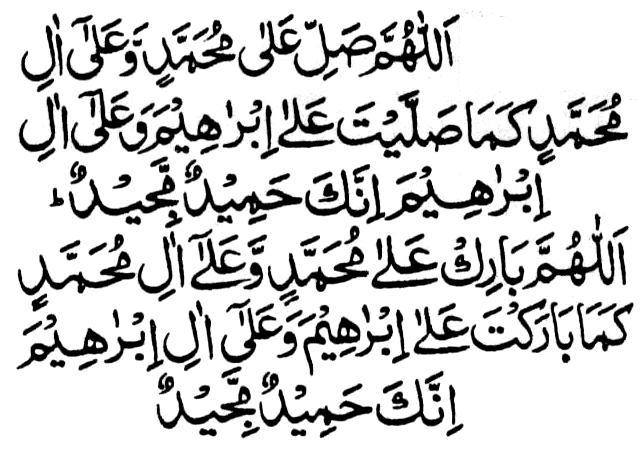
7. Thereafter, the Takbeer should be said for the THIRD time and the following Dua be recited for an adult male or female:
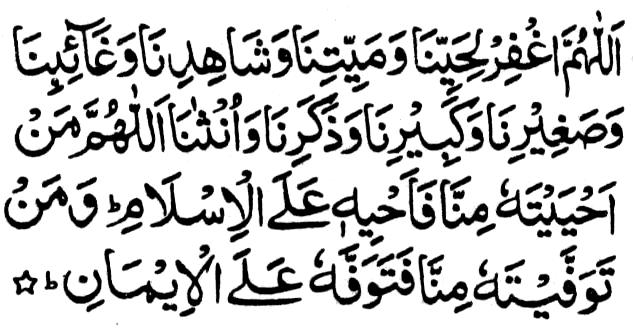
For a child who has not reached the age of puberty the following Dua should be recited after the THIRD Takbeeer:
a. Dua for boy:- 
b. Dua for girl:- 
8. The Imaam should say the FOURTH Takbeer and thereafter recite the Salaam aloud TWICE while turning his face first towards the RIGHT shoulder and then once again while turning his face towards the left. The Muqtadis should follow by saying the Takbeer and Salaam SOFTLY.
When a LATE COMER FEARS that if he engages himself in WUDHU, he will
miss the Janaazah Salaat, then ONLY is it permissible for him to make TAYAMMUM
and join the Jama'at. This rule applies to the Janaazah Salaat only.
Whomsoever arrives for the Janaazah Salaat after the Imam has recited
ONE or more Takbeers, should wait and join the Imam when he says the next
Takbeer. After the Salaam he should complete the missed Takbeers by merely
saying Allahu Akbar once for every Takbeer missed. NO Dua should be read.
If the Imam has completed the FOURTH Takbeer then too, the late comer should
join and complete all the missed Takbeers (before the Imam says the Salaam).
1. After the Janaazah Salaat is performed the Mayyit should be buried
as soon as possible. The Janaazah should be carried and placed. at the
Qiblah side of the grave. The head should be on the RIGHT SIDE side of
the grave if one faces the QIBLAH.
2. It is desirable that MAHRAMS or close relatives (of a female Mayyit)
should enter the grave to lower the body. The husband should NOT enter
the grave to bury his wife. It is NOT MASNOON (Sunnat) that there be an
ODD number. All those who enter the grave should face the Qiblah.
3. It is MUSTAHAB to hold a sheet over the grave while lowering and
burying a female. If there is fear of her Kafn opening then it is WAJIB
to do so.
4. It is MUSTAHAB for those present to recite this Dua whilst the body
is being lowered:

5. After placing the body into the recess of the grave it is Masnoon
to turn it onto it's RIGHT side to face the Qiblah.
6. The strips of cloth tied at the head side, chest and leg side should
now be untied.
7. The recess should then be covered with unbaked bricks, bamboo or
timber.
1. It is MUSTAHAB to begin closing the recess or trench from the LEG
side for MALES and from the HEAD side for FEMALES. All the remaining little
openings should be closed with mud or grass. The use of any FABRIC or BLANKETS
is unnecessary and wasteful. All those present should participate to fill
the KABR with at least THREE handfuls of soil.
When throwing the, FIRST handful in the grave RECITE:

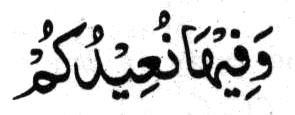

2. It is MAKROOH to add more soil to the Kabr than that which was dug
out from it.
3. The shape of the Kabr when filled should be like the HUMP of a CAMEL.
The height should be approximately 25 to 30 cms. It should NOT be made
SQUARE or into any other shape. All types of buildings and enclosures on
or around the Kabr are NOT permissible. Buildings on Qabr have been emphatically
denounced in the hadith of Rasulullah ![]() .
.
4. It is MUSTAHAB to sprinkle water on the grave from the head to the
leg side thrice after the Kabr has been shaped.
5. To recited the Quraan and make Dua for the deceased at his grave
side after the grave is filled and shaped, is also MUSTAHAB.
6. It has been related be Hazrat Uthmaan that after Rasulullah ![]() buried the dead, he paused and said, “Beseech forgiveness from Allah
for your brother and make Dua for his steadfastness because he is going
to be questioned now by the MUNKAR and NAKEER."
buried the dead, he paused and said, “Beseech forgiveness from Allah
for your brother and make Dua for his steadfastness because he is going
to be questioned now by the MUNKAR and NAKEER."
7. After the burial the first Ruku of Suratul Bakarah should be read
at the head side of the Kabr:-
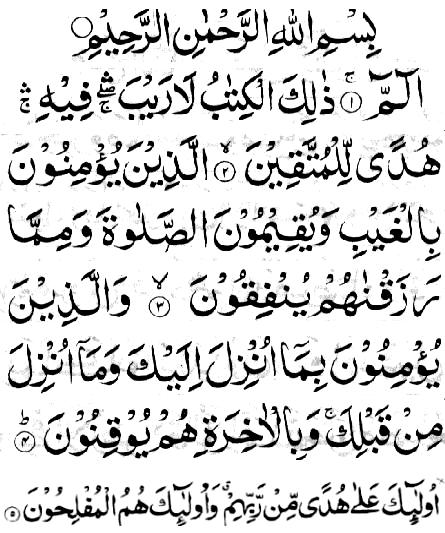
and the last Ruku of Suratul Bakarah should be read to the leg side:-
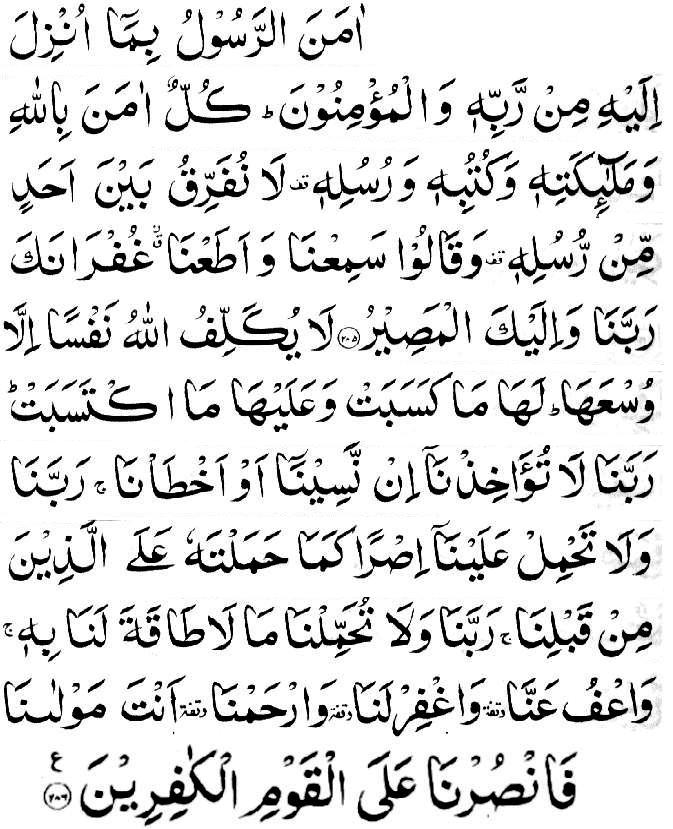


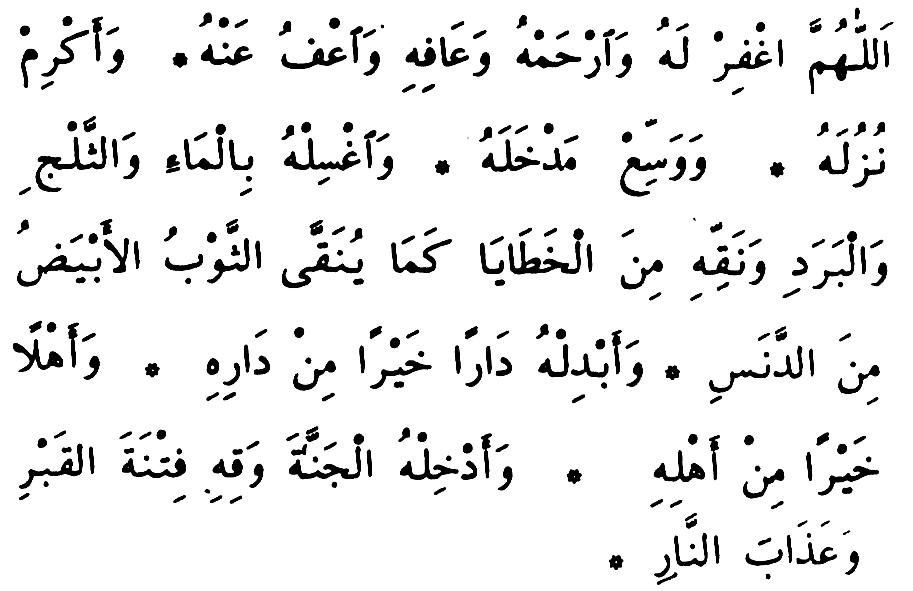


It is from the teachings of Rasulullah ![]() that one should console and comfort a Muslim who is in distress. Rasulullah
that one should console and comfort a Muslim who is in distress. Rasulullah![]() has said: "He who consoles the one in distress shall be rewarded
as much as the bereaved."
has said: "He who consoles the one in distress shall be rewarded
as much as the bereaved."
ONE SHOULD TAKE NOTE OF THESE FEW POINTS:
- One should be most HUMBLE.
- Express his GRIEF.
- Speak less about WORLDLY affairs.
- Should NOT joke or laugh.
- Mention the good acts and deeds of the deceased and abstain from the ill ones.
-
Rasulullah
 has said, "Mention the GOOD actions of your deceased and abstain
from the OFFENSIVE ones."
has said, "Mention the GOOD actions of your deceased and abstain
from the OFFENSIVE ones."
Rasulullah ![]() has mentioned, "Visit the graves, for surely visiting the graves
lessens worldly love and reminds you of the hereafter." The Qabrastaan
could be visited on any day. Friday is preferred for this visit and if
possible it should be a weekly visit. It has been related in a Hadith that,
"Whoever will visit his parents grave every Friday will be granted
Maghfirat and he will be recorded as an obedient son of his parents."
has mentioned, "Visit the graves, for surely visiting the graves
lessens worldly love and reminds you of the hereafter." The Qabrastaan
could be visited on any day. Friday is preferred for this visit and if
possible it should be a weekly visit. It has been related in a Hadith that,
"Whoever will visit his parents grave every Friday will be granted
Maghfirat and he will be recorded as an obedient son of his parents."
Rasulullah ![]() has taught the Sahabah
has taught the Sahabah ![]() these words as salutation to the people of the graves and pray for their
forgiveness:
these words as salutation to the people of the graves and pray for their
forgiveness:

There are many supplications that may be read at the grave side, the
best being the recital of the Holy Quraan. Stand facing the grave (back
towards the Qiblah) and recite as much of the Quraan as possible and make
Dua for the Maghfirat (forgiveness) of the departed. A few ways of praying
for the dead, as related in the AHAADEES, are given hereafter;
Recite Sura IKHLAAS 
It is related in a Hadith that whoever visits the Qabrastaan and recites
Surah IKHLAAS 11 times and then prayed for the dead, will be rewarded as
many fold as the number of dead in the Qabrastaan.
It has been reported in a Hadith that whoever visits the Qabrastaan
and recites Surahs:
FAATIHAH:
IKHLAAS:
TAKAASUR:
- ALHAMDU
- QULHUWALLAH and
- ALHAKUMUT TAKAASUR
Recite Surah YASEEN
 .
In a Hadith it is reported that if a person recites Surah YASEEN in the
Qabrastaan, the punishment of the dead will be eased and the reciter will
be rewarded just as much as the dead.
.
In a Hadith it is reported that if a person recites Surah YASEEN in the
Qabrastaan, the punishment of the dead will be eased and the reciter will
be rewarded just as much as the dead.
In this manner the Sahaabah of Rasulullah
1. The period of WAITING after one's HUSBAND dies is called IDDAT. This
period is of FOUR months and TEN days.
2. During this period she should remain in the dwelling that they occupied
at the time of the death of her husband. She is NOT allowed to leave this
house if she has sufficient provision. If she is the sole bread winner
with no other means of income, then only is she permitted to leave her
house during the day. At night she should return to his house.
3. The widow that is expecting a child at the time of the death of
her husband, her Iddat will be until the birth of that child. The four
month and ten days should NOT be reckoned in this instance.
4. If a woman is NOT at home at the time of her husband's death, she
should return as soon as possible and pass the period of Iddat at home.
The days of Iddat will be calculated from the time of the demise.
5. A woman in Iddat should abstain from using fancy clothing, make-up
or jewellery.
The trustee of the deceased should pay all the DEBTS as soon as possible. Isaale Thawaab for the deceased should be made by feeding the poor, by giving Sadaqah, making Istighfaar etc. NO SPECIFIC dates or days such as the third, seventh, eleventh or fortieth are mentioned in Shari'ah for such devotions. When giving charity on behalf of the deceased, it is desirable to make Niyyah for the fulfilment of Qaza Salaat of the deceased.
The Shari'at has NOT specified any particular type or colour of clothing that should be worn by those that are bereaved.
A Mayyit is one who was born ALIVE and then passed away. It must be named and Ghusl, Kafn and Janaazah must be performed.
A STILL BORN child should be named, given Ghusl and wrapped in a piece of cloth, (NO Kafn) and then buried.
In the case of a miscarriage, if the limbs are formed, then too, it will be named, given Ghusl, wrapped in a piece of cloth and buried just as a still born child.
There is NO Janaazah Salaat for still born babies.
If the limbs are NOT formed, no name will be given and there will be NO Ghusl. The malformed child should just be wrapped in a piece of cloth and buried.
If any one of the parents of a dead child is a Muslim, then that child will be regarded as a Muslim. Janaazah Salaat should be performed for that child.
Janaazah Salaat shall be said for a person that has committed suicide. It is desirable that someone other than the appointed Imaam or reputable person of the community lead this prayer. Janaazah Salaat will be performed for all Muslims, pious or sinful.
It has been narrated by Hazrat Abu Hurairah ![]() that Rasulullah
that Rasulullah ![]() said: "One that accompanies the Janaazah of a Muslim with sincerity
and with the intention of Sawaab, and remains with it until the Salaat
is performed and the Mayyit buried will return (home) with TWO Qeeraat
Sawaab. Of these, one Qeeraat is equal to the mountain of UHUD. A person
who only performs the Janaazah Salaat and returns, will return with one
Qeeraat Sawaab."
said: "One that accompanies the Janaazah of a Muslim with sincerity
and with the intention of Sawaab, and remains with it until the Salaat
is performed and the Mayyit buried will return (home) with TWO Qeeraat
Sawaab. Of these, one Qeeraat is equal to the mountain of UHUD. A person
who only performs the Janaazah Salaat and returns, will return with one
Qeeraat Sawaab."
Women do NOT follow the Janaazah nor do they visit the Qabrastaan.
